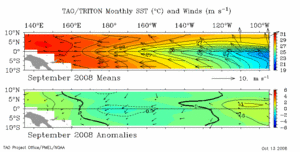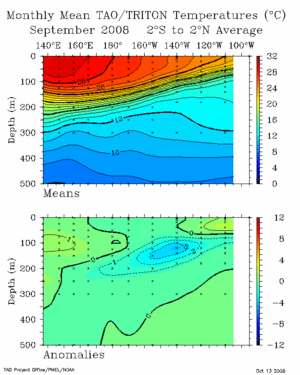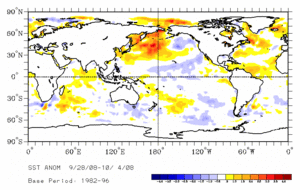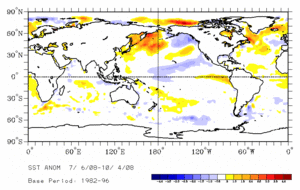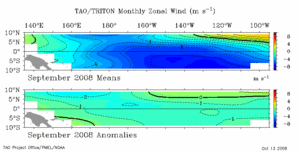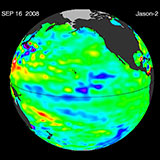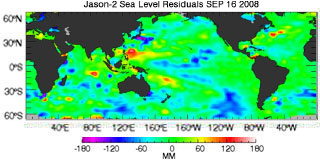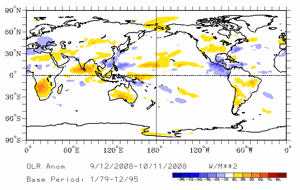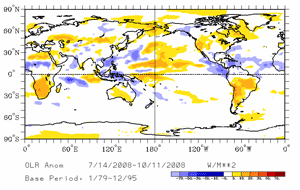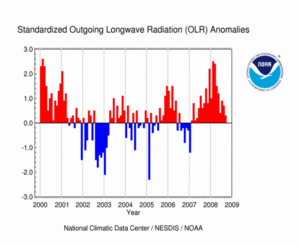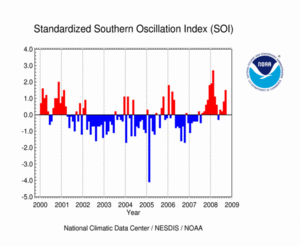ENSO-Neutral Conditions Persist Across Equatorial Pacific
Sea Surface Temperatures (SSTs) and Mixed Layer Conditions:
Since February 2008, negative sea surface temperature anomalies have weakened over the equatorial Pacific Ocean, and positive anomalies have expanded westward into the east-central equatorial Pacific Ocean. During September, SSTs continued to be slightly above average over a large portion of the equatorial Pacific Ocean. The ENSO-neutral conditions indicated by the near normal SSTs are also borne out by the above average upper-ocean heat anomalies and normal thermocline slope index. Monthly ENSO indices are all near normal.
The Niño 3.4 Index region (map of Niño regions) SST anomaly was -0.16°C (-0.29°F), which was a decrease of 0.3°C (0.54°F) compared with the August index value of -0.14°C (-0.25°F). Likewise, the Niño 4 Index region (western Pacific) SST anomaly cooled 0.10°C (0.18°F) relative to August to -0.27°C (-0.49°F). For the most recent equatorial Pacific Ocean surface temperatures, please visit NOAA's Tropical Atmosphere Ocean (TAO) project and for weekly or monthly Niño region average SST and anomaly values, visit CPC's Atmospheric and SST Index values page.
With the continued warming of SSTs in the Niño 3.4 index region over the past few months, the 3-month (July-September) running mean was 0.00°C (0.00°F), which is well within the Oceanic Niño Index (ONI) threshold of +/-0.5°C (+/-0.9°F) for neutral conditions (NOTE: For NOAA's official ENSO classification scheme, please see NOAA's El Niño/La Niña Index Definition).
The CPC's most recent ENSO Diagnostic Discussion indicated that ENSO-neutral conditions should persist though the first half of next year, and while not ruling out a small chance of El Niño development by late this year, the CPC feels that neutral conditions are likely to remain in place through the boreal spring (austral fall) 2009. The ENSO Wrap-Up from the Australian Bureau of Meteorology (BoM) also reflected the presence of ENSO-neutral conditions and expected continuation of these conditions across the tropical Pacific basin through the end of 2008 (see the Australian BoM ENSO Wrap-Up).
Equatorial Zonal Winds (U-Component Winds) and Sea-Level Topography:
September trade winds in the central and western Pacific fluctuated around the long-term mean, although low-level flow in the far western Pacific was stronger than average. Decreased trades continued their presence in the central and eastern equatorial Pacific.
Pacific sea levels measured by the NASA/JPL Jason-1 satellite also reflected ENSO-neutral conditions across the tropical Pacific Ocean in September. Much of the central equatorial Pacific was near normal in September. The tropics west of the Date Line also had near average sea level heights for the month. An area of negative sea level anomalies persisted into September north and south of the Equator in the central Pacific, and substantial positive anomalies were present in the far western Pacific region.
Outgoing Longwave Radiation (OLR):
In September, OLR values continued to drop slightly due to increased convection over portions of the equatorial Pacific around and east of the Date Line. The map below on the left shows the spatial pattern of global OLR (in Wm-2) measured by satellite during September. The lack of convection along the Equator near the Date Line has persisted since the development of the cold event in late May 2007. The suppression of convection in the western Pacific is more clearly seen in the 3-month average OLR anomalies map (below right).
The monthly OLR anomaly for September was +0.3 Wm-2 averaged across an area in the western Pacific between 160° E and 160° W. This was the 20th consecutive month that the OLR index had a positive monthly value. However, September's value remains lower than those experienced during the most recent La Niña event. Persistently high positive OLR indices are typical of the mature phase of a La Niña episode, while negative values indicate the presence of increased convection and warm phase conditions.
Note that high frequency variability in OLR is typically associated with the Madden-Julian Oscillation (MJO), which is convective activity that propagates west to east in the near-equatorial region from the Indian Ocean into the Pacific Ocean approximately every 30-60 days. The latest MJO activity can be seen in CPC's graphs of Daily MJO Indices.
Southern Oscillation Index (SOI):
The Southern Oscillation Index (SOI) was once again positive in September. The standardized monthly averaged value was +1.5, compared to +0.8 in August. These SOI values generally correspond with ENSO-neutral conditions over the equatorial Pacific. [Consistently positive (negative) values of the SOI are typical of La Niña (El Niño) conditions.]
Additional Links
- ENSO Monitoring
- NOAA El Niño / La Niña Index Definition
- NOAA's Pacific Marine Environmental Laboratory (PMEL):
- NOAA's Climate Prediction Center (CPC):
- NOAA's Physical Science Laboratory
- NASA/JPL Ocean Surface Topography from Space
- Australian Bureau of Meteorology (BoM) Climate Driver Update
- IRI - International Research Institute
 NOAA's National Centers for Environmental Information
NOAA's National Centers for Environmental Information
